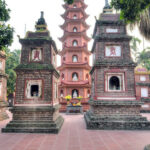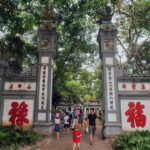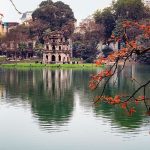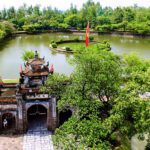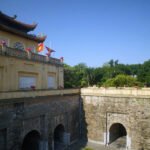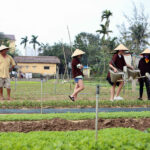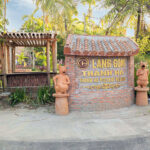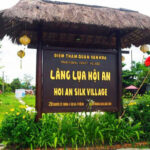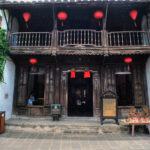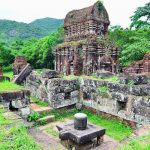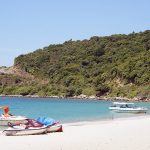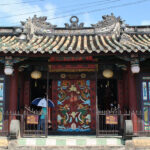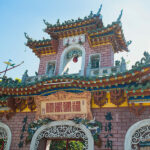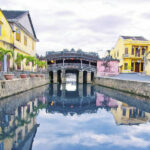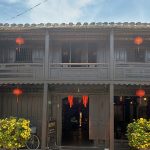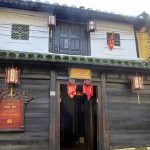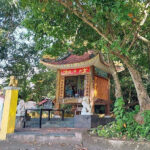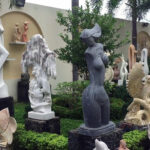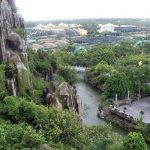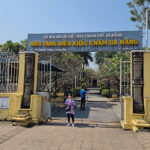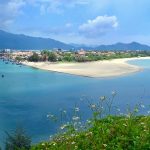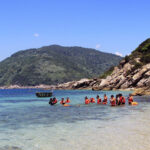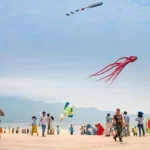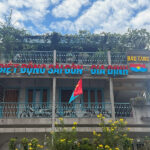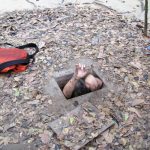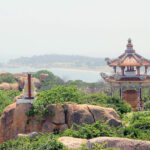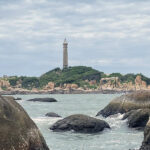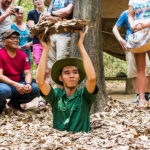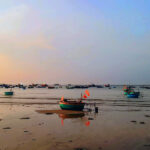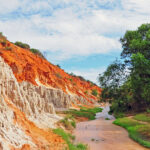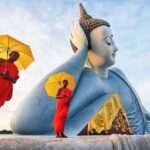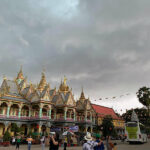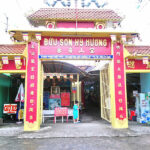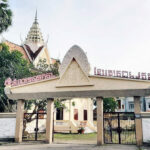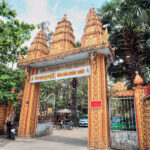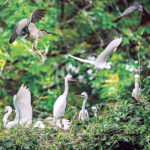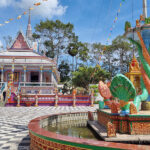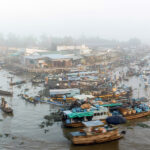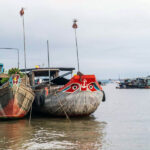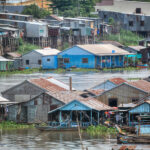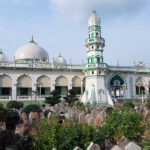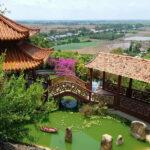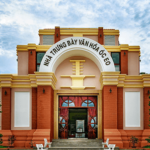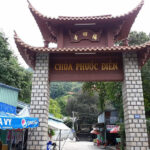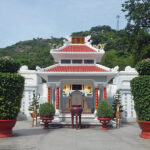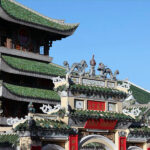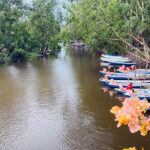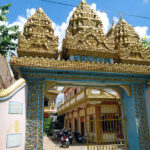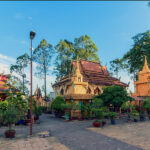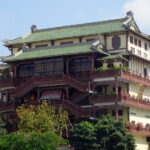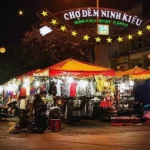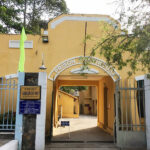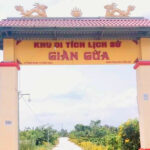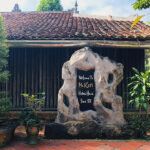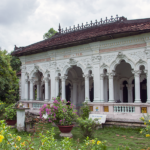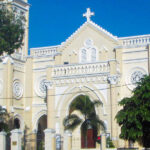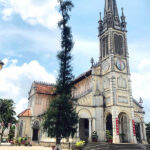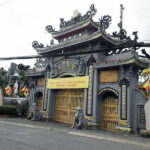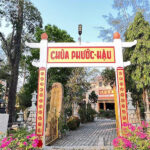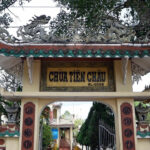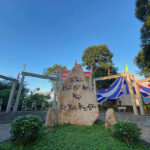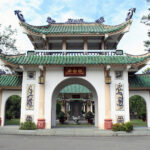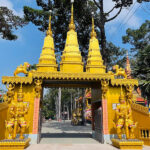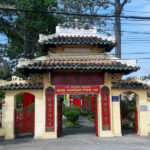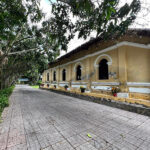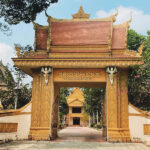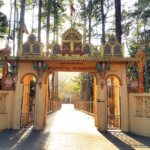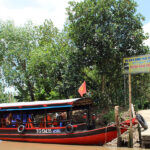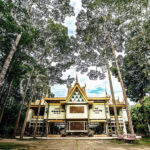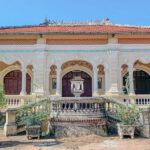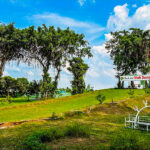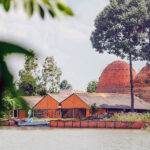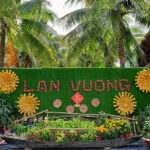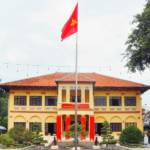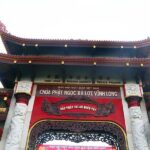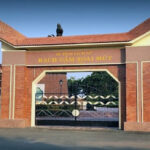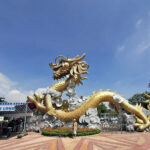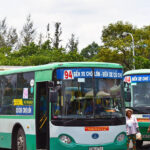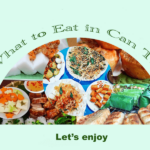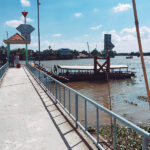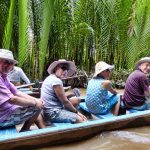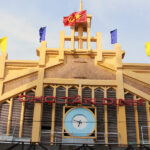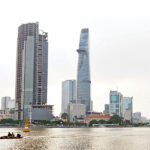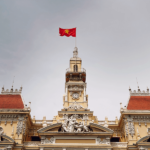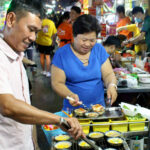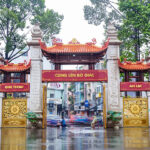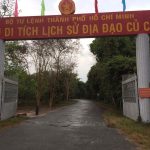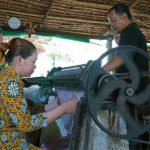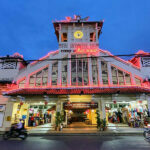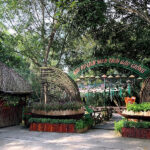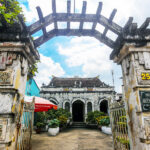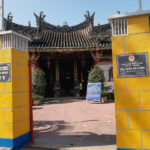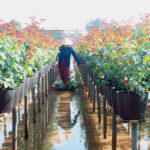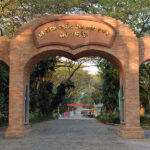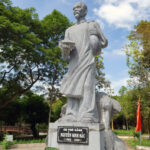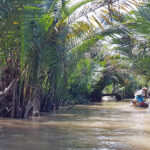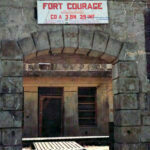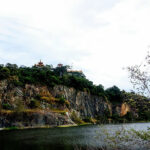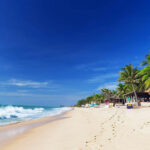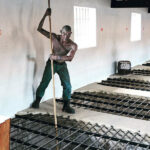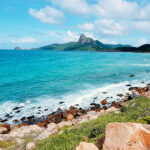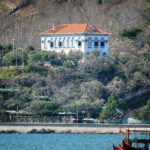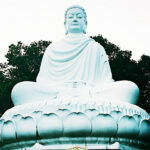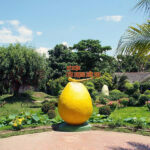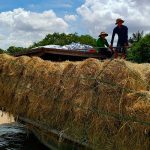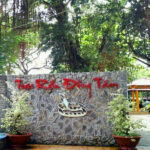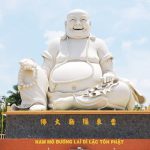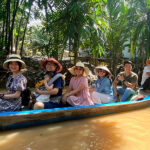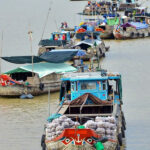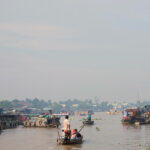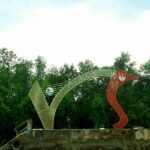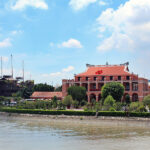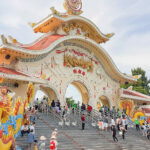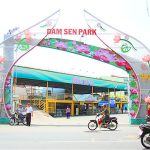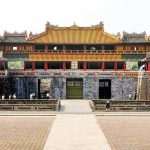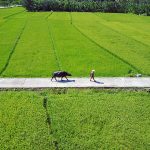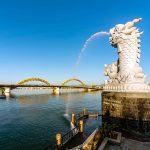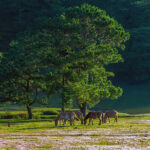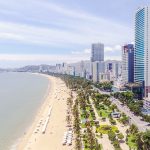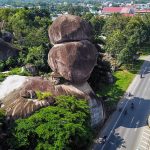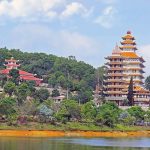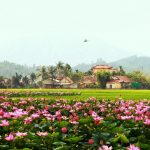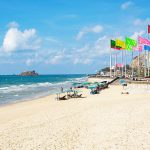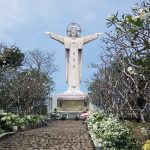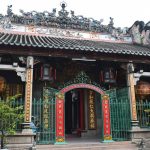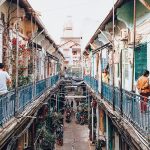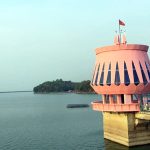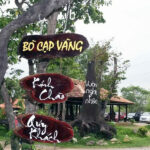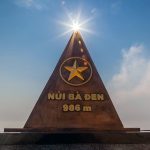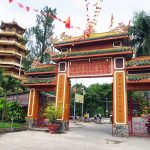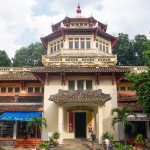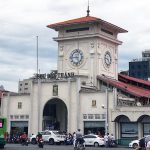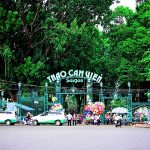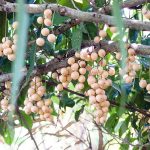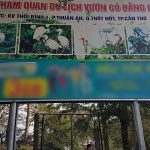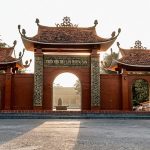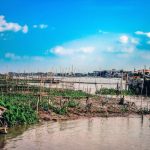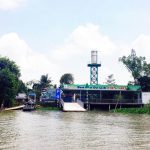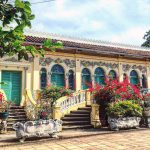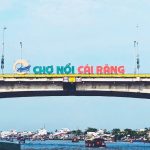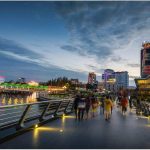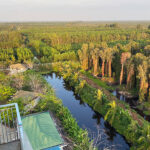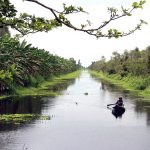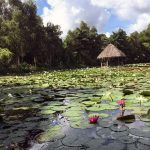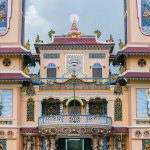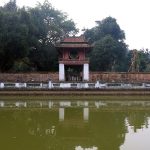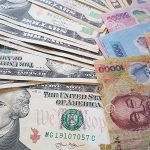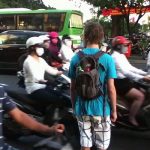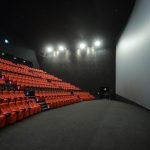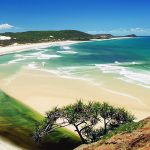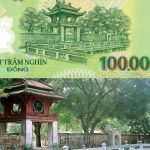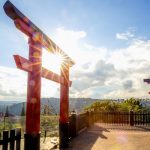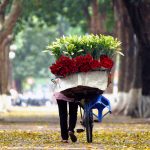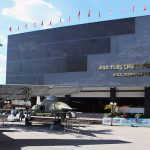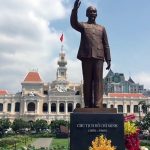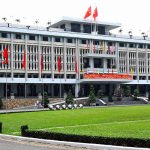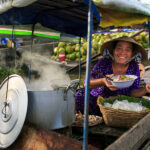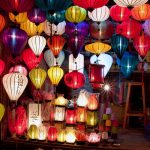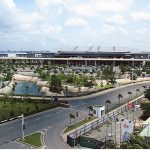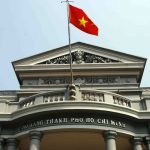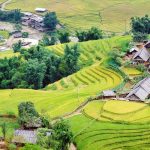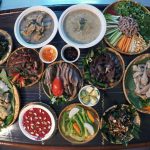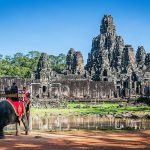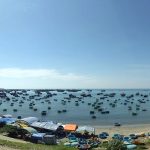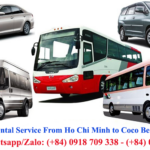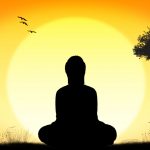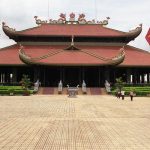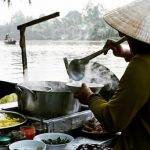Hanoi (Vietnamese: Hà Nội) is the capital of Vietnam, an incomparable combination of tradition, elegance, and progress. Hanoi means “the hinterland between the rivers”. The portion of the Red River embracing Hanoi is approximately 30km long. Hanoi contains 18 beautiful lakes, which are the lungs of the city, surrounding gardens and trees providing a vital source of energy.
Beside many building booms, there is a centuries-old quarter which represents the eternal soul of the city. Most locals and foreigners often call it “Hà Nội – Ba mươi sáu phố phường” (translated as “Ha Noi – 36 districts” or “Hanoi – 36 Old Streets”), or “Phố cổ Hà Nội” (translated as “Hanoi Old Quarter”).
Table of Contents
Which season should you travel to explore Hanoi?
Hanoi has a climate divided into 4 distinct seasons. Each time, the capital has its own beauty, so you can explore Hanoi at any time of the year:
Spring: starts from February to April. The weather in the capital is chilly at this time, characterized by sudden drizzle. Hanoi people often call the drizzle at the beginning of the year with the intimate name spring rain. Traveling to Hanoi this season, you will be immersed in the vibrant colors of flowers. A spring trip to Nhat Tan peach village, Tay Tuu flower village or Quang Ba flower market could not be a more ideal choice.
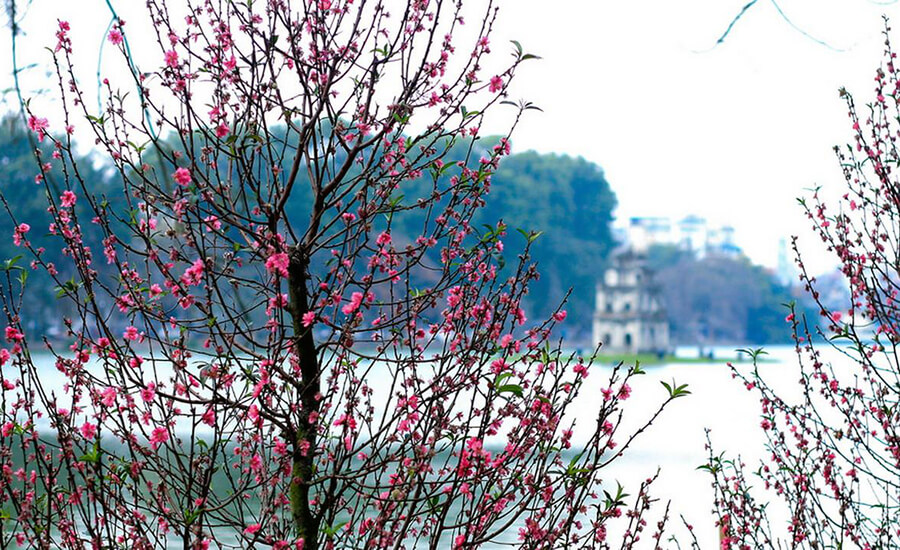
Summer: starting from May to July, the capital begins to enter summer, characterized by sweltering heat. These days, Hanoi people often sit together at the corner of West Lake and enjoy cool Trang Tien ice cream. Traveling to the capital this season, you can have a picnic at Thong Nhat Park, Yen So Park or visit shopping centers like Times City, Royal City to have fun and escape the sun.
Autumn: begins in August and lasts until October. This is also the time when the capital is more romantic and dreamy than ever. Autumn in Hanoi is filled with milk flowers and the faint scent of fresh green rice. Coming to the capital this season, don’t forget to wander around Phan Dinh Phung street filled with yellow leaves, visit West Lake to watch the sunset and enjoy the specialties of Hanoi’s autumn.
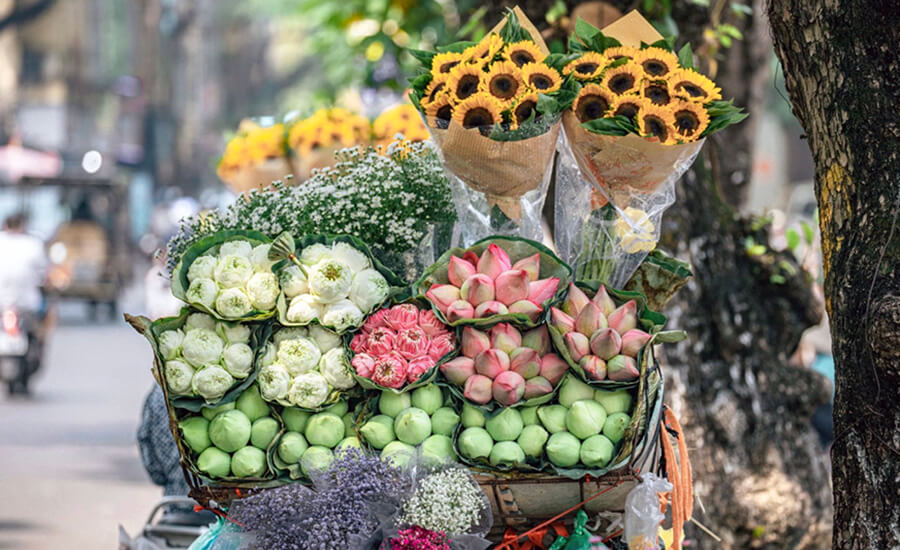
Winter: starts from November and lasts until the end of January of the following year. This season is characterized by a cold that penetrates the skin but still makes many people sob because of its lyrical beauty. If you travel to Hanoi in the early days of winter, you can walk around street corners such as Dinh Le, Phan Dinh Phung… to see street flower baskets filled with white daisies.
Transportation to and in Hanoi
Hanoi is considered the heart of Vietnam, so visitors can travel easily to the capital by plane, train, bus, private car or motorbike from other provinces.
To move around the city, you can go by car, motorbike or bicycle. But the experience will be more poetic if you sit on a cyclo and admire 36 streets, or go on a tour of a three-wheeled motorbike or vintage Vespa. Another suggestion worth considering is a double-decker bus, ticket prices range from 330,000 – 599,000 VND.
WHAT TO SEE
Every single natural sight and historical monument in Hanoi is spectacularly related to a legend. The more you know about the stories of Hanoi, the more fascinating you will feel about its history and culture.
Typical architectural works
The capital Hanoi has many monuments and architectural works dating back thousands of years. Many works are considered symbols of Hanoi, a favorite destination of domestic and foreign tourists.
Temple of Literature
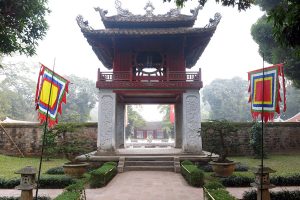 The Temple of Literature was built in 1070 under Emperor Ly Thanh Tong and is a place of worship of Confucius, honors Viet Nam’s finest intellectuals and men of literary accomplishment. At this time, the entrance was only granted to the king’s son and noble families but after 1442, the Temple of Literature accepted the children of civilians with excellent academic ability.
The Temple of Literature was built in 1070 under Emperor Ly Thanh Tong and is a place of worship of Confucius, honors Viet Nam’s finest intellectuals and men of literary accomplishment. At this time, the entrance was only granted to the king’s son and noble families but after 1442, the Temple of Literature accepted the children of civilians with excellent academic ability.
The current complex of Van Mieu – Quoc Tu Giam relics is located on a 54331 m² site, including many small architectural works. In the Temple of Literature divided into 5 distinct areas, each area has separated walls and connecting gates.
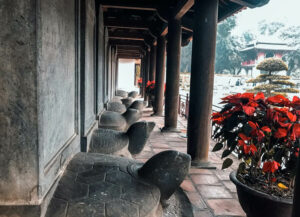
The first area stretches from the main gate to the Dai Trung gate, the two sides have small gates of Thanh Duc gate and Dat Tai gate; the second from the Dai Trung gate to Khue Van Cac, which has been recognized as a symbol of Hanoi city. You will find doctors’ names listed on a stele above tortoise backs in the third courtyard. Each stele was made of stone. There are still 82 steles of the examinations from 1442 to 1779, with names and origins of 1307 doctors. These are the most precious relics of the monument.
Today, visitors can visit the stone steles and solemn grounds with lotus ponds. The Temple of Literature is a rare peaceful and quiet place in the middle of a bustling city. Visitors will feel the harmony between ancient and modern times when coming here through the thousand-year-old walls.
Address: 58 P. Quoc Tu Giam, Van Mieu, Dong Da District.
Tran Quoc Pagoda
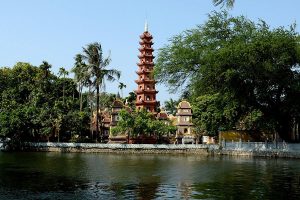 Tran Quoc Pagoda, located on an island in West Lake, is one of the oldest pagodas in Vietnam, after many times of relocated and reparation. The Pagoda constructed in the sixth century during the reign of Emperor Ly Nam De (from 544 until 548). The pagoda has so many architecture works placed very harmonious, specific for the rule of Buddhism architecture.
Tran Quoc Pagoda, located on an island in West Lake, is one of the oldest pagodas in Vietnam, after many times of relocated and reparation. The Pagoda constructed in the sixth century during the reign of Emperor Ly Nam De (from 544 until 548). The pagoda has so many architecture works placed very harmonious, specific for the rule of Buddhism architecture.
There are many lotus flower statues locate around the pagoda. These symbolize purity of the mind, body, and speech. The pagoda has a stupa, built-in 1998, consists of 11 floors with a total of 15m hight. Each tower floor has 6 arched doorways, in each space is a statue of Amitabha Buddha made of precious stones.
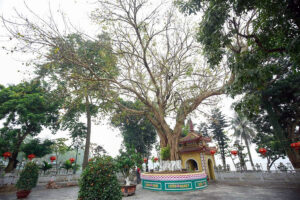 This stupa was symmetrically erected with a large Bodhi tree, given by the President of India when he visited Hanoi in 1959, which taken as cutting of the original tree in Bodh Gaya, India under which the Buddha sat and achieved enlightenment. Inside, there is a precious statue of Sakyamuni Buddha entering Nirvana, which is a masterpiece of Vietnamese sculptural art. A stela dating from 1639 tells the story of this pagoda. At the main shrine, the visitors are given incense to be burned. Visitors to the shrine also give offerings like food or small amounts of money as a present for the gods to give themselves good luck.
This stupa was symmetrically erected with a large Bodhi tree, given by the President of India when he visited Hanoi in 1959, which taken as cutting of the original tree in Bodh Gaya, India under which the Buddha sat and achieved enlightenment. Inside, there is a precious statue of Sakyamuni Buddha entering Nirvana, which is a masterpiece of Vietnamese sculptural art. A stela dating from 1639 tells the story of this pagoda. At the main shrine, the visitors are given incense to be burned. Visitors to the shrine also give offerings like food or small amounts of money as a present for the gods to give themselves good luck.
With more than 1500 years old, became a symbol of Ha Noi architecture. Nowadays, tourist still comes here not only for ceremonial offerings but also for visiting sites.
Address: 46 Thanh Nien Street, Yen Phu, Tay Ho District.
President Ho Chi Minh’s Mausoleum
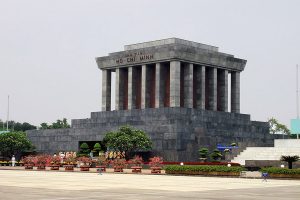 Located in the center of Ba Dinh Square, Ho Chi Minh Mausoleum is one of the most significant historical destinations in Ha Noi. This is where President Ho Chi Minh read the Declaration of Independence of Vietnam and is also his resting place.
Located in the center of Ba Dinh Square, Ho Chi Minh Mausoleum is one of the most significant historical destinations in Ha Noi. This is where President Ho Chi Minh read the Declaration of Independence of Vietnam and is also his resting place.
This project was the result of a close collaboration between engineers from the Soviet Union and Vietnam in order to keep the remains of President Ho Chi Minh. The mausoleum is divided into 3 floors. The first one is. a terraced stand exclusively used for grand meetings organize at Ba Dinh Square.
The second floor is the center of the mausoleum, where the remains of the president are kept in a chamber, accessible through a series of passages and flight of marble stairs. The upper floors is the roof. The facade f the upper floor bears the inscription “President Ho Chi Minh” in a dark violet precious stone.
For Vietnamese, this is one of the most important attractions in the country. Tourists come to pay their respects to President Ho Chi Minh. Visitors need to keep quiet, wear appropriate clothing and not take photos in prohibited areas.
The Mausoleum closes two days a week, Friday and Monday. Also, it opens from 7:30 – 10:30 on Tuesday, Wednesday, Thursday, and from 7:30 – 11:00 Saturday and Sunday.
Address: 01 Hung Vuong, Dien Bien, Ba Dinh District.
Co Loa Citadel
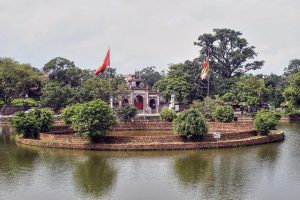 Co Loa Citadel is perhaps the most ancient citadel in Vietnam. It remained an important political center of the Vietnamese people until the 10th century.
Co Loa Citadel is perhaps the most ancient citadel in Vietnam. It remained an important political center of the Vietnamese people until the 10th century.
According to folklore, it was built by An Duong Vuong in the 3rd century BC to be the capital of Au Lac Kingdom (the name of Vietnam at the time). The site was build according to a helical design and was surrounded by three ramparts and a deep moat.
The remains of the citadel are located on the same site where archaeologists have found tens of thousands of bronze arrowheads, iron axes, and animal bones. Close to the citadel are the remains of Co Loa Communal House, a temple devoted to the cult of Princess My Chau and An Duong Vuong a King who loved his daughter with all his heart but lacking vigilance, left Co Loa and lost both his family and his country.
Location: Thon Chua, Dong Anh District.
One Pillar Pagoda
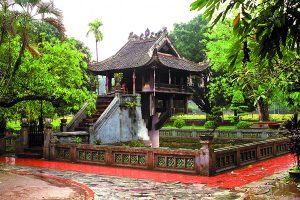 The original name of the One Pillar Pagoda was Dien Huu Pagoda which literally means “long-lasting happiness and good luck”. The pagoda is located in the western part of the city on Ong Ich Khiem St., near Ho Chi Minh’s Mausoleum. It was first built in 1049, during the reign of Emperor Ly Thai Tong, who had no children, often went to pagodas to pray to Buddha for a son. One night, he dreamed that he was granted a private audience with Buddha. Buddha seated on a lotus flower in square-shaped lotus pond on the western side of Thang Long Citadel gave the king a baby boy. Months later, when the queen gave birth t a male child, the Emperor ordered the construction of a pagoda supported by only one pillar to resemble the lotus seat of his dream in the honor of Buddha.
The original name of the One Pillar Pagoda was Dien Huu Pagoda which literally means “long-lasting happiness and good luck”. The pagoda is located in the western part of the city on Ong Ich Khiem St., near Ho Chi Minh’s Mausoleum. It was first built in 1049, during the reign of Emperor Ly Thai Tong, who had no children, often went to pagodas to pray to Buddha for a son. One night, he dreamed that he was granted a private audience with Buddha. Buddha seated on a lotus flower in square-shaped lotus pond on the western side of Thang Long Citadel gave the king a baby boy. Months later, when the queen gave birth t a male child, the Emperor ordered the construction of a pagoda supported by only one pillar to resemble the lotus seat of his dream in the honor of Buddha.
The pagoda is located P.Chua Mot Cot, Doi Can, Ba Dinh.
Imperial Citadel of Thang Long
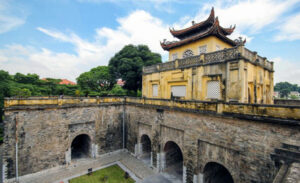 Thang Long Imperial Citadel is a world cultural heritage located in the heart of Hanoi and has a history of more than 1,300 years. This place contains unique relics, demonstrating the history of Vietnamese people through many eras.
Thang Long Imperial Citadel is a world cultural heritage located in the heart of Hanoi and has a history of more than 1,300 years. This place contains unique relics, demonstrating the history of Vietnamese people through many eras.
The project stands out with its massive architecture built over many feudal dynasties of Vietnam. Through many historical ups and downs, most of the original works at Thang Long Imperial Citadel no longer exist, but this place is still the most attractive tourist destination in Hanoi. The relics have a relationship and connection with each other, forming a complex but rich and attractive whole, clearly reflecting the relationship of urban planning and architectural space, as well as continuity between dynasties in the history of building Thang Long (one of the old name of Ha Noi) capital.
Address: 19C Hoang Dieu, Dien Ban, Ba Dinh.
St. Joseph’s Cathedral
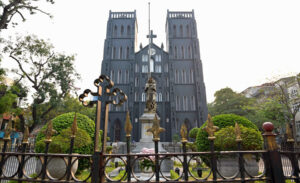 The Cathedral is the most beautiful churches and is also the Cathedral of the Archdiocese of Hanoi. The church is designed in the European medieval Gothic architectural style, which was very popular in the 12th century. The main construction materials of the church were terracotta bricks and walls plastered with paper. The church is 64.5m long, 20.5m wide and has two 31.5m high bell towers with heavy stone pillars at four corners. At the top is a stone cross. The doors and all windows were designed according to Gothic art, combined with beautiful and harmonious stained glass paintings of Saints, creating a source of natural light inside the church. The sanctuary and altars are decorated with traditional folk art, carved with unique and sophisticated wooden patterns painted in red lacquer and gilded. In the main hall, there is a terracotta statue of Saint Joseph over 2 meters high.
The Cathedral is the most beautiful churches and is also the Cathedral of the Archdiocese of Hanoi. The church is designed in the European medieval Gothic architectural style, which was very popular in the 12th century. The main construction materials of the church were terracotta bricks and walls plastered with paper. The church is 64.5m long, 20.5m wide and has two 31.5m high bell towers with heavy stone pillars at four corners. At the top is a stone cross. The doors and all windows were designed according to Gothic art, combined with beautiful and harmonious stained glass paintings of Saints, creating a source of natural light inside the church. The sanctuary and altars are decorated with traditional folk art, carved with unique and sophisticated wooden patterns painted in red lacquer and gilded. In the main hall, there is a terracotta statue of Saint Joseph over 2 meters high.
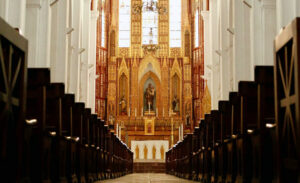
The church also has a set of bells, including four small bells and one large bell. Especially the large clock mounted in the middle of the church facade. The clock has an engraved alarm, time alarm, and alarm system linked to 5 bells hanging on two towers. In the center of the square in front of the church is a metal statue of the Virgin Mary. Around the church are palanquins, flower beds, and a stone grotto behind.
Currently, this is not only a religious symbol but also a place for entertainment and public exchanges for the people of the capital.
Address: 40 P.Nha Chung, Hang Trong, Hoan Kiem District.
Long Bien Bridge
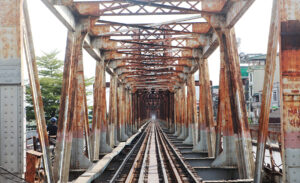 Not only simply spanning the two banks of the Red River, Long Bien Bridge is also a mark connecting the present and the old memories of people who love Hanoi. Long Bien Bridge was built in 1898, people also call it Song Cai Bridge or Bo De Bridge because the bridge spans Bo De wharf, Gia Lam, Hanoi. With a length of 1,682 m and an 896 m long approach bridge, Long Bien bridge is divided into 9 frames, each frame is 61 m long. According to the original design, the bridge has a total of 19 steel beam spans placed on 20 pillars over 40 m high. Currently, the bridge is for a single railway running in the middle, with two lanes for motor vehicles and pedestrians on both sides. The special thing is that the traffic flow in the forward direction of the bridge is on the left side, not the right side like other bridges.
Not only simply spanning the two banks of the Red River, Long Bien Bridge is also a mark connecting the present and the old memories of people who love Hanoi. Long Bien Bridge was built in 1898, people also call it Song Cai Bridge or Bo De Bridge because the bridge spans Bo De wharf, Gia Lam, Hanoi. With a length of 1,682 m and an 896 m long approach bridge, Long Bien bridge is divided into 9 frames, each frame is 61 m long. According to the original design, the bridge has a total of 19 steel beam spans placed on 20 pillars over 40 m high. Currently, the bridge is for a single railway running in the middle, with two lanes for motor vehicles and pedestrians on both sides. The special thing is that the traffic flow in the forward direction of the bridge is on the left side, not the right side like other bridges.
The bridge is a witness to many ups and downs in Vietnamese history. This ancient bridge is a cultural, historical and architectural symbol of the Capital. Coming here, in addition to exploring ancient architecture, you can also freely check in with amazing shooting angles.
Location: Long Bien bridge, Ngoc Thuy, Hoan Kiem District.
Hanoi Opera House
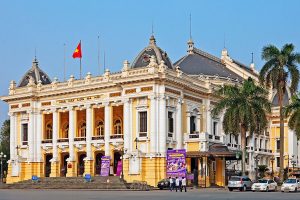 Hanoi Opera House is the favorite destination whenever visitors have an opportunity to visit the capital. It was erected by the French colonial administration between 1901 and 1911. It was modeled on the style of the Paris Opera.
Hanoi Opera House is the favorite destination whenever visitors have an opportunity to visit the capital. It was erected by the French colonial administration between 1901 and 1911. It was modeled on the style of the Paris Opera.
The house is 87m long and 30m wide. The interior consists of a large stage and the main audience room which holds more than 900 seats. The second floor has many small compartments. The first and the second floor has a balcony in the front and two staircases that help audiences easy to go upstairs or downstair.
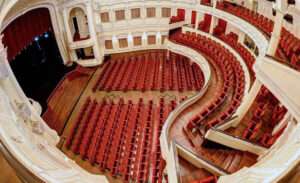
Behind the stage are the management room; 18 make-up rooms, the rehearsal room, and the meeting hall. During the colonial period, the opera house depended on touring artists performing French and Italian repertoire for a mainly French audience. It also hosted many significant historical events associated with the August Revolution and the early years of Viet Nam Democratic Republic.
After the departure of the French, the building was used for Vietnamese plays, musicals, art shows, cultural activities, and other international events.
Located at the center of Hanoi, No.1 Trang Tien Street, Hoan Kiem District.
Flag Tower of Hanoi
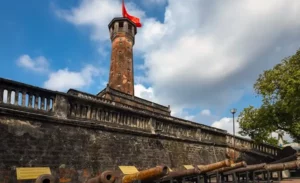 Hanoi Flag Tower is a national historical and cultural relic, built in 1805 and completed in 1912, on the southern part of Thang Long Imperial Citadel. Through many ups and downs of history, this unique architectural work has become a historical witness, witnessing the nation’s great transformations.
Hanoi Flag Tower is a national historical and cultural relic, built in 1805 and completed in 1912, on the southern part of Thang Long Imperial Citadel. Through many ups and downs of history, this unique architectural work has become a historical witness, witnessing the nation’s great transformations.
The architecture of the flag towner includes 3 base levels and a column body, over 41m high. Overall, the flag tower consists of stacked prisms, shrinking and gradually increasing from bottom to top. That balanced layout creates straight, strong, steady lines, very harmonious and elegant, doesn’t feel heavy at all. Inside, there is a staircase of 54 steps that spirals up to the top. The top of the tower is formed into an octagonal floor, with 8 doors corresponding to 8 sides. In the middle of the floor is a tall, round pillar where placed the flag pole. Atop the Hanoi Flag Tower always has a red flag with a five-pointed yellow star. This tower represent as a symbol of glory and pride of the nation, the independent of Vietnam.
Address: 28A Dien Bien Phu, Dien Bien, Ba Dinh District.
Museums
Each museum is a place to display and preserve ancient documents and artifacts about ethnic groups or historical periods. The museum in Hanoi currently displays documents and artifacts and provides diverse knowledge about many fields of history, culture, and military of Vietnam.
Hoa Lo Prison
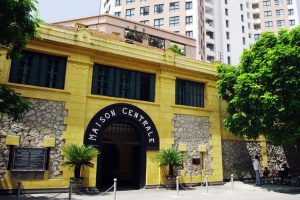 This historical site is located on the street of the same name. Built-in 1896, the French colonialist used Hoa Lo to imprison many patriots and communist prisoners. There were many Communists who were kept and tortured there, some of them are very famous like Nguyen Van Kien or general secretary Truong Chinh.
This historical site is located on the street of the same name. Built-in 1896, the French colonialist used Hoa Lo to imprison many patriots and communist prisoners. There were many Communists who were kept and tortured there, some of them are very famous like Nguyen Van Kien or general secretary Truong Chinh.
After the peace was established in 1954, this site was used by the Vietnamese Government as a jail for criminal prisoners. It was also a place to keep American Pilots during the anti-US war in the North. The museum is open daily, except Monday, from 8 am to 11.30 am and 13.30 pm to 16.30 pm.
Address: 1 P. Hoa Lo, Tran Hung Dao, Hoan Kiem District.
Vietnam Women’s Museum
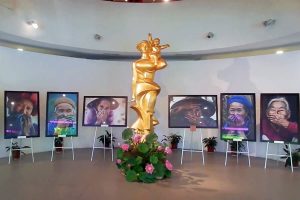 This museum is dedicated to Vietnamese women. It was open on the 20th of October 1995 on the occasion of 65 years’ birthday of the Vietnamese Women’s Association. More than 1000 materials, photos, documents, objects are displayed and carefully preserved and maintained in the permanent exhibition that shows the role the Vietnamese women played in history and currently play in arts and in family life.
This museum is dedicated to Vietnamese women. It was open on the 20th of October 1995 on the occasion of 65 years’ birthday of the Vietnamese Women’s Association. More than 1000 materials, photos, documents, objects are displayed and carefully preserved and maintained in the permanent exhibition that shows the role the Vietnamese women played in history and currently play in arts and in family life.
A museum is also a place for cultural exchange for Vietnamese and international women with the goal of creating “equality, development, and peace”. This is a great chance for you to explore know how gender politics play out in Vietnam, through the shows of the museum.
Address: 36 P. Ly Thuong Kiet, Hang Bai, Hoan Kiem District, near the central Hoan Kiem Lake and the old quarter.
Vietnam Museum of Fine Arts
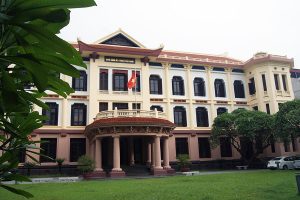 In June 1966, the house No 66 on Nguyen Thai Hoc St. in Ba Dinh District, was transformed into the Vietnam Museum of Fine Arts, from a range of historical periods and much of the 20th Century art and folk narratives of a nation in defense were showcased in the first primary art museum of Viet Nam. The second was the smaller – Ho Chi Minh City Museum of Fine Arts.
In June 1966, the house No 66 on Nguyen Thai Hoc St. in Ba Dinh District, was transformed into the Vietnam Museum of Fine Arts, from a range of historical periods and much of the 20th Century art and folk narratives of a nation in defense were showcased in the first primary art museum of Viet Nam. The second was the smaller – Ho Chi Minh City Museum of Fine Arts.
There are many collections that draw on themes of martyrdom, patriotism, military strategy, and overcoming enemy incursion. A small collection of late 20th and early 21st Century paintings was presented in the museum including works by artists exploring abstraction and abstract impressionism, giving greater attention to the individualist artist.
Vietnam National Museum of History
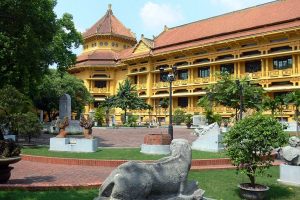 The Vietnam National Museum of History is located in the Hoan Kiem district, right in the heart of Hanoi. It was founded in September 1958, located just behind the Hanoi Opera House at No1 Trang Tien St., the museum contains plenty of valuable objects, which reflect from thousand years prehistory to the present days, in its 2,000 m2 area. On the ground floor is about the period from prehistoric to the Nguyen Dynasty. The second floor features Vietnam from modern history from 1858 until now. The museum is a tourist attraction not only for Vietnamese people but also for foreign visitors. It is opened in the morning from 8:00 – 12:00, and in the afternoon from 13:30 – 17:00.
The Vietnam National Museum of History is located in the Hoan Kiem district, right in the heart of Hanoi. It was founded in September 1958, located just behind the Hanoi Opera House at No1 Trang Tien St., the museum contains plenty of valuable objects, which reflect from thousand years prehistory to the present days, in its 2,000 m2 area. On the ground floor is about the period from prehistoric to the Nguyen Dynasty. The second floor features Vietnam from modern history from 1858 until now. The museum is a tourist attraction not only for Vietnamese people but also for foreign visitors. It is opened in the morning from 8:00 – 12:00, and in the afternoon from 13:30 – 17:00.
You will need to buy an entrance ticket, which is 40.000 VND/ticket. It should be noticed also that in order to take photos or filming within the premises, you will have to pay for an amount varying from 15.000 to 30.000 VND.
Vietnam Museum of Ethnology
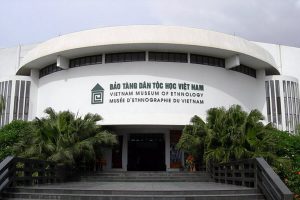 The Vietnamese Museum of Ethnology opened at the end of 1997. Since then, it has attracted the attention of visitors as well as ethnographers and researchers from all over the world.
The Vietnamese Museum of Ethnology opened at the end of 1997. Since then, it has attracted the attention of visitors as well as ethnographers and researchers from all over the world.
It contains more than 10,000 objects; 15.000 black and white photos and hundreds of vides tapes and cassetles which depict all aspects of life, activities, customers, and habits of the 54 ethnic minorities of Vietnam that are being displayed and labeled in Vietnamese, English, and French.
The Ethnological Museum has successfully recreated the daily life together with the religious rituals and the symbolic festivals of each ethnic group in Vietnam. During certain periods of time, such as the Vietnamese New Year, and Mid-Autumn Festival, the Museum organizes series of activities from traditional games to authentic culture shows by the ethnic people, and thus it is very crowded.
The museum is located on Nguyen Van Huyen Road in Cau Giay District, about 8 km from the city center,
Should not miss
Coming to Hanoi, you will feel a bustling and dynamic life from early morning until late at night. Besides famous works, there are many places that attract many tourists come to visit.
Hoan Kiem Lake
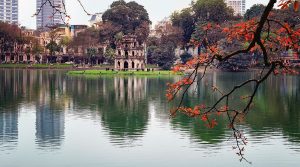 Hoan Kiem is a natural freshwater lake of Hanoi city, connecting the streets of Hang Ngang, Hang Dao, Cau Go, Luong Van Can, Lo Su… with the Western Quarter planned by the French more than a century ago. The centuries are Bao Khanh, Nha Tho, Trang Thi, Hang Bai, Dinh Tien Hoang, Trang Tien…Next to the lake are architectural works of great spiritual significance to the Vietnamese people such as: The Huc bridge, Turtle tower, Ngoc Son temple…
Hoan Kiem is a natural freshwater lake of Hanoi city, connecting the streets of Hang Ngang, Hang Dao, Cau Go, Luong Van Can, Lo Su… with the Western Quarter planned by the French more than a century ago. The centuries are Bao Khanh, Nha Tho, Trang Thi, Hang Bai, Dinh Tien Hoang, Trang Tien…Next to the lake are architectural works of great spiritual significance to the Vietnamese people such as: The Huc bridge, Turtle tower, Ngoc Son temple…
Coming to Hoan Kiem Lake, in addition to walking and enjoying the fresh nature, visitors You can also visit the old town to check in and enjoy many specialty dishes. Especially on every weekend, Hoan Kiem Lake organizes a crowded and bustling walking street. This is the ideal time for you to immerse yourself in the crowd, experience many fun activities and enjoy many unique performances.
Old Quarter
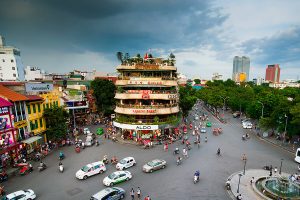 Located north of Hoan Kiem Lake, this area is one of the most attractive places not only for international visitors but also for domestic. Each street name represents a product or profession that is sold by local people. For example, Hang Duong (Sugar St.), Hang Dao (Peach St.)…especially on the weekend, some of the roads, in this area, are being used as a walking area. The interesting thing about Hanoi’s pedestrian street is no modern games or technology services but it is attractive by many traditional folk games.
Located north of Hoan Kiem Lake, this area is one of the most attractive places not only for international visitors but also for domestic. Each street name represents a product or profession that is sold by local people. For example, Hang Duong (Sugar St.), Hang Dao (Peach St.)…especially on the weekend, some of the roads, in this area, are being used as a walking area. The interesting thing about Hanoi’s pedestrian street is no modern games or technology services but it is attractive by many traditional folk games.
Along the streets, you can easily see groups of performers with different styles and types of music. From lively Latin American music to light music, orchestral music, traditional art forms. Coming to the old quater today, you can still enjoy the ancient, time-tinged space of low-style houses, tiled roofs, and moss walls. Furthermore, if you’re looking for souvenirs or want to enjoy local street food with, Old Quarter is an area you should not miss.
Bat Trang Pottery Village
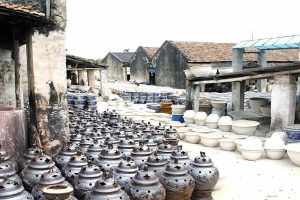 Located in Gia Lam District, by the banks of the Red River, Bat Trang Pottery Village is a famous destination in Hanoi. With more than 7 centuries of history, it is a well know traditional professional handicraft village.
Located in Gia Lam District, by the banks of the Red River, Bat Trang Pottery Village is a famous destination in Hanoi. With more than 7 centuries of history, it is a well know traditional professional handicraft village.
Their products are made from a particular type of white clay. Each family has their own pottery making techniques. They made a variety of bowls, plates, cups, vases, and incense burners. The decorations and designs on these works are also very special.
Visiting the Bat Trang Pottery village to experience the rural life and the profusion of pottery and ceramic wares.
Duong Lam Ancient Village
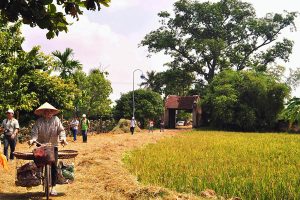 Duong Lam ancient village can be said as a great choice when you need to move away from the noisy, and bustle of the city. Duong Lam ancient village is a small village located in Son Tay district, Hanoi city, just over 40km from the center of the capital.
Duong Lam ancient village can be said as a great choice when you need to move away from the noisy, and bustle of the city. Duong Lam ancient village is a small village located in Son Tay district, Hanoi city, just over 40km from the center of the capital.
Over hundreds of years of existence, Duong Lam ancient village still preserves ancient architectural works, landscapes such as village gates, banyan trees, wharves, communal yards. The village also is well-known by many cultural and historical relics including temples, pagodas, stone steles.
Duong Lam has more than nine hundred traditional houses with special construction – being built from the laterite blocks.
Annually, Duong Lam organizes the local festivals to honor the national heroes. There are two most ideal times of the year to explore this small village: the festive season or the rice harvest season. The festive season in Duong Lam usually takes place around January of the lunar calendar every year. At this time in Duong Lam village, there will be quite a lot of unique and interesting festival activities. The most famous of which is the Mong Phu village ceremony, which takes place from the 4th to the 10th of January every year.
In addition, the period of the rice harvest season in May and June is also the time when Duong Lam ancient village receives the most tourists. Around this time Duong Lam village appeared with an incredibly peaceful atmosphere.
WHAT TO EAT
Hanoi not only attracts visitors with famous landmarks, but also known as a “culinary paradise” with countless variety of reasonable and tasty eats and drinks, ranging from soups, noodles, rolls, fries, and sandwiches perfectly paired with plenty of fresh herbs to fresh beer, coffee and green tea. Compared to other cities in Vietnam, Hanoi food tends to be on the sweeter side; less sour and utilizes freshwater ingredients such as prawns, squids, shrimps, crabs, clams, and mussels. Since a trip to Hanoi won’t be completed without trying its traditional delicacies, here’s a list of dishes that you should try for at least one time.
Vietnamese Pho
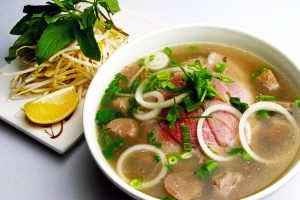 Pho (Vietnamese: Phở) has never been a culinary symbol not only in this place but also as one of the national culinary symbols. This delicate traditional Vietnamese dish, has been associated with Vietnamese people for generations. You can taste it in other cities but, for sue, it won’t be the same as in Hanoi. Besides the main ingredients (flat rice noodle; the broth is made from long-boiled beef bones and spices; meat, spices, herbs…) Pho Hanoi has its own cooking recipe. The chef adds “ruoi” – Nereididae, into the broth to create special flavor and select only fresh, soft cake that is not crushed to serve customers. Also, you can enjoy it in the form of “pho xao”, which is stir-fried with onions, beef slices, assorted greens, and sometimes with adding extra fried eggs and chili sauce to this simple & satisfying dish.
Pho (Vietnamese: Phở) has never been a culinary symbol not only in this place but also as one of the national culinary symbols. This delicate traditional Vietnamese dish, has been associated with Vietnamese people for generations. You can taste it in other cities but, for sue, it won’t be the same as in Hanoi. Besides the main ingredients (flat rice noodle; the broth is made from long-boiled beef bones and spices; meat, spices, herbs…) Pho Hanoi has its own cooking recipe. The chef adds “ruoi” – Nereididae, into the broth to create special flavor and select only fresh, soft cake that is not crushed to serve customers. Also, you can enjoy it in the form of “pho xao”, which is stir-fried with onions, beef slices, assorted greens, and sometimes with adding extra fried eggs and chili sauce to this simple & satisfying dish.
Some recommend addresses: Pho Gia Truyen (49 Bat Dan, Hoan Kiem District); Pho Thin (13 Lo Duc, Hai Ba Trung District; Pho Ly Quoc Su (No 10 Ly Quoc Su, Hoan Kiem District); Pho Suong (36B Mai Hac De, Hai Ba Trung District); Pho Bung (01 Hang Trong, Hoan Kiem District)….
Fresh rice vermicelli
Hanoians have many fresh rice vermicelli dishes. The most special ones are Bun Cha (Vietnamese Grilled Pork Meatballs with rice vermicelli), Bun Rieu (Rice Noodles in crab and tomato broth), Bun Thang (Rice Noodle with Chicken, Egg, Pork) and so on.
Bun Cha (Vietnamese Grilled Pork Meatballs with rice vermicelli)
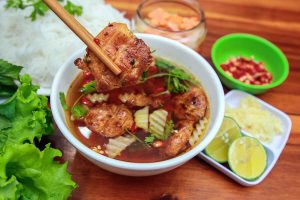
Bun Cha (Vietnamese: Bún Chả) is a classic dish in the North. It’s the dish that Barack Obama and Anthony Bourdain shared on his trip to Vietnam in May 2016. It’s a combination of grilled pork in a cold broth, rice noodles, fresh herbs, and served in a bowl of “nước chấm” – fish sauce mixed with garlic, chili, sugar, and lime juice. You’ll also typically find a few pickled vegetables floating in the bowl as well.
Some recommend addresses: Bun cha Sinh Tu (Cau Giay District); Bun Cha Dac Kim – Hang Manh (Hoan Kiem District); Bun Cha Huong Lien (24 Le Van Huu, Hai Ba Trung District); Bun Cha Nguyen Bieu (23 Nguyen Bieu, Ba Dinh District)…
Bun Rieu (Rice Noodles in crab and tomato broth)
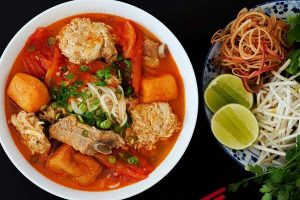 Bun Rieu (Vietnamese: bún riêu) comprises thin rice noodles with shrimp paste, tofu, vegetables, and herbs that are served in rice paddy crab and tomato broth. The delicious taste of crabs, the sourness of tomatoes with the rich broth cannot be mixed, the bun rieu has left visitors with a truly unforgettable impression. Some of the local shops usually served extra with pork and shrimp sauce to this dish.
Bun Rieu (Vietnamese: bún riêu) comprises thin rice noodles with shrimp paste, tofu, vegetables, and herbs that are served in rice paddy crab and tomato broth. The delicious taste of crabs, the sourness of tomatoes with the rich broth cannot be mixed, the bun rieu has left visitors with a truly unforgettable impression. Some of the local shops usually served extra with pork and shrimp sauce to this dish.
Where to eat Bun Rieu in Ha Noi: Bun Rieu Huyen Thu (2F Quang Trung, Hoan Kiem District); Bun Rieu Trang (23 Nguyen Sieu, Hoan Kiem District); Bun Rieu Thanh Hong (42 Hoa Ma, Hai Ba Trung District); Bun Rieu (7B Ly Quoc Su, Hoan Kiem District)…
Bun Thang (Rice Noodle with Chicken, Egg, Pork)
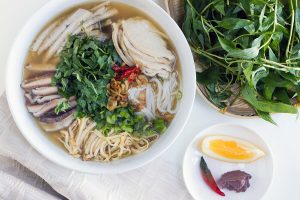 Bun thang (Vietnamese: bún thang) a special dish as its broth. It consists of many nutritious ingredients mixed together including dried shrimp, squid, shrimp paste, spring onion, coriander, ginger, mushroom, beet, fish sauce, sugar candy, vinegar…to make the broth. Some local shops add more noodles, chicken, eggs, pork slices, and a dollop of shrimp paste that make bun thang not only delicious food but also a very nutritious one.
Bun thang (Vietnamese: bún thang) a special dish as its broth. It consists of many nutritious ingredients mixed together including dried shrimp, squid, shrimp paste, spring onion, coriander, ginger, mushroom, beet, fish sauce, sugar candy, vinegar…to make the broth. Some local shops add more noodles, chicken, eggs, pork slices, and a dollop of shrimp paste that make bun thang not only delicious food but also a very nutritious one.
Where to eat Bun Thang in Hanoi: Bun Thang Ba Duc (48 Cau Go, Dong Da District); Bun Thang Ngoc Tuyen (56 & 58 Dao Tan, Ba Dinh District); Bun Thang Thuan Ly (33 Hang Hom, Hoan Kiem District); Bun Thang – Quan Cu (31A Phan Dinh Phung, Ba Dinh District)…
Xoi xeo (Sticky Rice with Mung Bean Topping)
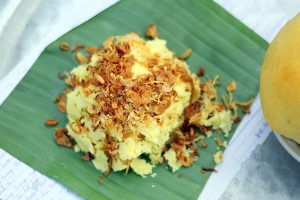 Xoi Xeo (Vietnamese: Xôi Xéo) is a typical breakfast food for local people. It starts with glutinous rice cooked with mung bean and other delicious ingredients. A bright yellow sticky rice is often packaged in lotus leaf, then topped off with a drizzle of liquid fat and crispy fried shallot make a nondescript yet delectable scent of Xoi Xeo.
Xoi Xeo (Vietnamese: Xôi Xéo) is a typical breakfast food for local people. It starts with glutinous rice cooked with mung bean and other delicious ingredients. A bright yellow sticky rice is often packaged in lotus leaf, then topped off with a drizzle of liquid fat and crispy fried shallot make a nondescript yet delectable scent of Xoi Xeo.
Where to eat Xoi Xeo in Hanoi: Xoi Yen (35B Nguyen Huu Huan, Hoan Kiem District); Xoi Suon Cay (628 Truong Chinh, Dong Da District); Xoi Sen Minh Long (188 Quan Thanh, Ba Dinh District); Xoi Loc (68 Ta Quang Buu, Hai Ba Trung District)…
Banh Cuon (steamed rolled cake)
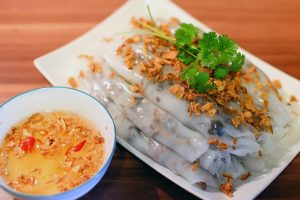 Stuffed with minced meat (normally from chicken, shrimp, or pork), onions, and finely chopped mushrooms, Banh Cuon (Vietnamese: Bánh cuốn) make a great breakfast or snack. It’s usually be served with fish sauce into for adding flavor.
Stuffed with minced meat (normally from chicken, shrimp, or pork), onions, and finely chopped mushrooms, Banh Cuon (Vietnamese: Bánh cuốn) make a great breakfast or snack. It’s usually be served with fish sauce into for adding flavor.
You can easily spot roadside vendors selling Banh Cuon all over Hanoi, but Banh Cuon Tay Ho is a good alternative as sellers offer this dish when it still hot which helps you get a full flavor.
Where to eat Banh Cuon in Hanoi: Banh Cuon Phuong (16 Dao Duy Tu, Hoan Kiem District); Banh Cuon Ba Xuan (16 Doc Hoe Nhai, Ba Dinh District); Banh Cuon Ba Hanh (26B Tho Xuong, Hoan Kiem District); Banh Cuon Quang An (71 Hang Bo, Hoan Kiem District); Banh Cuon Phu Ly (14 Cua Bac, Ba Dinh District)…
Cha ca (Grilled fish)
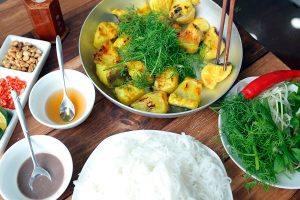 Cha ca (Vietnamese: chả cá) has long been a specialty of Hanoi. Names such as Cha ca La Vong; Cha ca Anh Vu, or Cha ca Lao Ngu… are considered super delicious grilled fish brands.
Cha ca (Vietnamese: chả cá) has long been a specialty of Hanoi. Names such as Cha ca La Vong; Cha ca Anh Vu, or Cha ca Lao Ngu… are considered super delicious grilled fish brands.
To make Cha Ca, the fish is deboned, cut into pieces, and mixed with turmeric and other spices. It is then wrapped in banana leaves and grilled over a charcoal fire. It’s usually be served with thin rice noodles, chili peppers, cilantro, peanuts, and a bowl of fish sauce.
Where to eat Cha Ca in Hanoi: Cha Ca La Vong (14 Cha Ca, Hoan Kiem District); Cha ca Thang Long (21 Duong Thanh, Hoan Kiem District); Cha Ca Anh Vu (120 K1 Giang Vo, Ba Dinh District); Cha ca Lao Ngu (171 Thai Ha, Hoan Kiem District)…
Bun Dau Mam Tom (Noodle and Tofu with Shrimp Sauce)
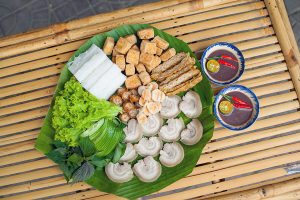 Bún đậu mắm tôm (Vietnamese) is quite simple but very popular in Vietnam. It’s originated from Hanoi. The rice noodles are served with deep-fried tofu, boiled pig gut, herbs, cucumber, and shrimp paste. While the shrimp paste doesn’t necessarily taste bad, the smell is pretty overpowering.
Bún đậu mắm tôm (Vietnamese) is quite simple but very popular in Vietnam. It’s originated from Hanoi. The rice noodles are served with deep-fried tofu, boiled pig gut, herbs, cucumber, and shrimp paste. While the shrimp paste doesn’t necessarily taste bad, the smell is pretty overpowering.
Where to eat Bun Dau Mam Tom in Hanoi: Bun Dau Mam Tom Cay Bang (129 Dai La, Hai Ba Trung District); Bun Dau Pho Co – Thanh Cong (No 111 K7 Thanh Cong, Ba Dinh District); Bun Dau Trung Huong (No 49 Ngo Phat Lo, Hoan Kiem District)…
WHAT TO BUY
Hanoi is the “shopping paradise” in the North of Viet Nam. From its bustling markets, colonial shophouses, flash boutiques, and shopping malls; you can find every strange unique thing that cannot be found anywhere else. Escape the afternoon heat to some shopping malls or local shop to bring some of these things back home with you like a small piece of Hanoi. And here is the list of some favorite products:
- Silk and Clothing
- Embroider
- Lacquerware
- Bamboo and Rattan goods
- Jewelry and Silver
- Dried fruit and O Mai (salted or sugared dry fruits)
THINGS TO DO AT NIGHTTIME
Hanoi is a city with so many unique things to do at night and is unlike any other vibrant city in Southeast Asia or even the world. And when you don’t want to spend time in rooftops and local bars, there are a multitude of fun and interesting things to see and places to go. Here are some of the best thing to try in this capital:
- Stroll around Hoan Kiem Lake: this is a cool place to walk around and snap some pictures at night. In the center of the lake is the Ngoc Son Temple, all the buildings, houses, bridges sparkle with lights that reflect on the water surface, creating a colorful sight.
- Water puppet show: featuring live music and water puppets to sketches of the ancient myths and folklore, this art performant has been favorite among tourists in Vietnam. To join the show, you can come to book a ticket at Thang Long Water Puppet Theatre In the Hoan Kiem District.
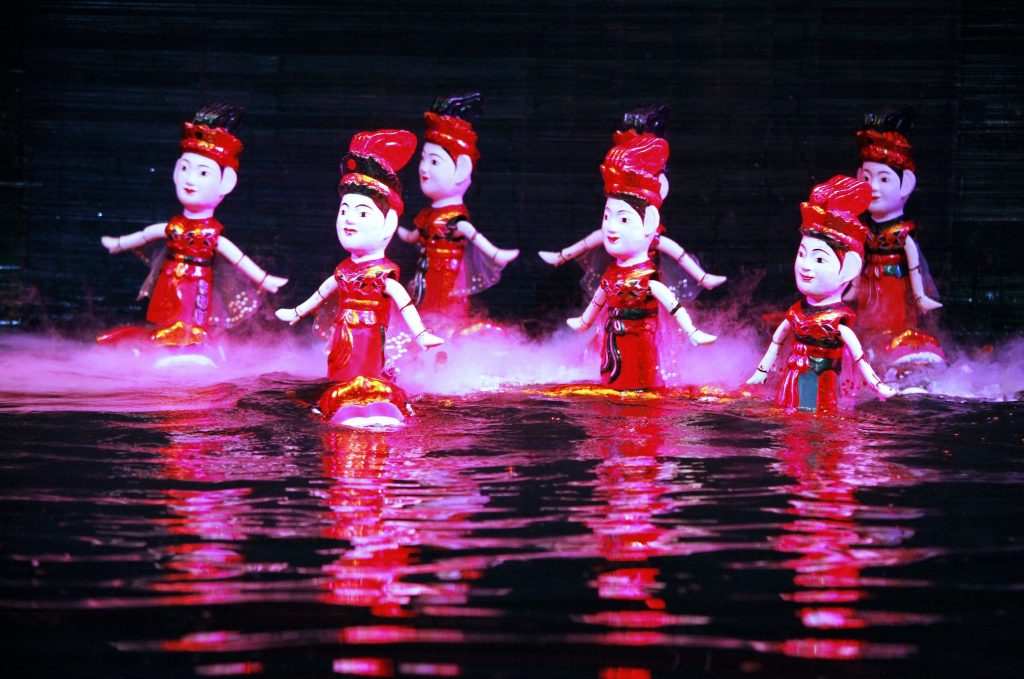
- The Bia Hoi Junction: located in the center of the Old Quarter, this is absolutely a classic night-time activity in Hanoi. There are many shophouses offer beers, with the most famous Beer Hoi (Fresh Beer) which cost only 10.000VND/1 plastic cup, serve on plastic tables and stools spilling out onto the sidewalk. This is a great place to make friends, as it’s almost always crowded with tourists.
- Stroll around and enjoy Hanoi Old Quarter street food is the best way for you to explore this area and enjoying local cuisine. From shophouses to vendors, they’re offering variety of unique delicious street foods at super cheap prices. But you should “understand your stomach” or at least, try to find a local guide for you.
- Dinner at West Lake – also called Hồ Tây in Vietnamese, is the largest lake in this city that have been attracting many foreigners coming to enjoy the fresh and cool air. Around the lake, there are many restaurants and bars that can bring you to a lovely night with a meal while feeling the beauty of the lake under the street lights in the evening.
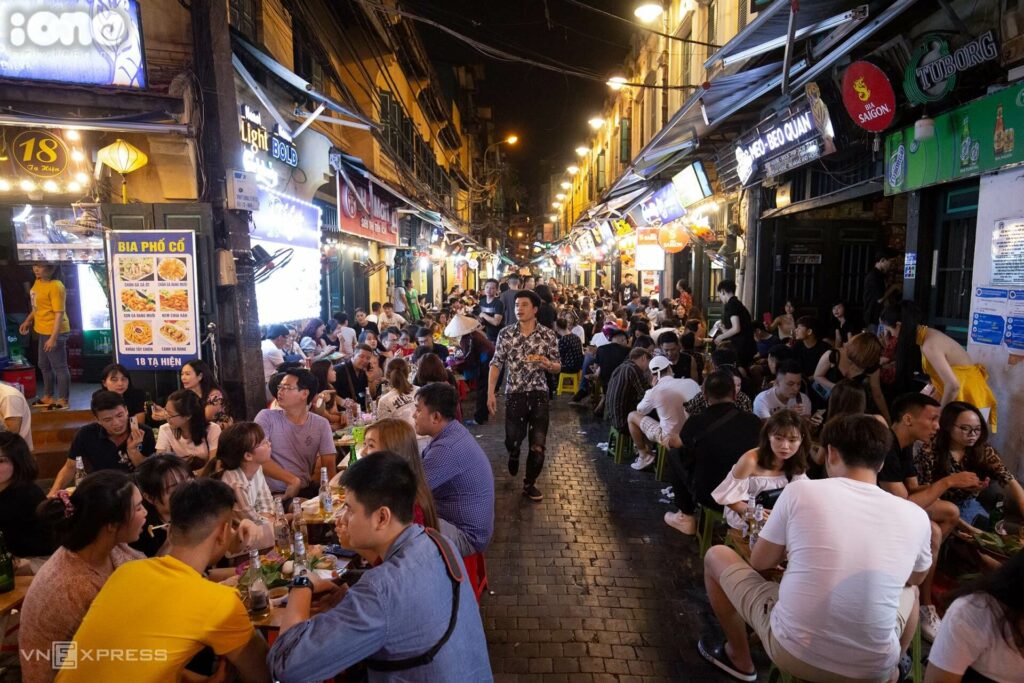
- Shopping at the Hanoi Night Market: explore the night markets even when you don’t want to do shopping. These are excellent places immerse yourself in the lively night-time atmosphere of Hanoi, meet people, snap some pictures, and enjoy some delicious street-side snacks. Some of the markets you should visit such as Dong Xuan Market, Quang Ba night flower market, Old Quarter night market…
- See Hanoi from above: a rooftop bar, café, or restaurant is a perfect destination when you want to see Hanoi from above. It’s a panoramic view of Hanoi from above. With the opened-air view, you will probably feel peaceful and fresh, completely different from the noisy and crowded of Hanoi that you see on the road.
Some of tourist attractions nearby Hanoi city are Halong Bay; Sapa; Hoa Lu – Tam Coc in Ninh Binh; Mai Chau in Hoa Binh…And besides some tour to explore Hanoi, Viet Dream Travel has designed other daily group and package tours that allow you easily choose the best one matching your time, budget, and your demand, so don’t hesitate to contact us.
Source: collected by L.N.H.An,


